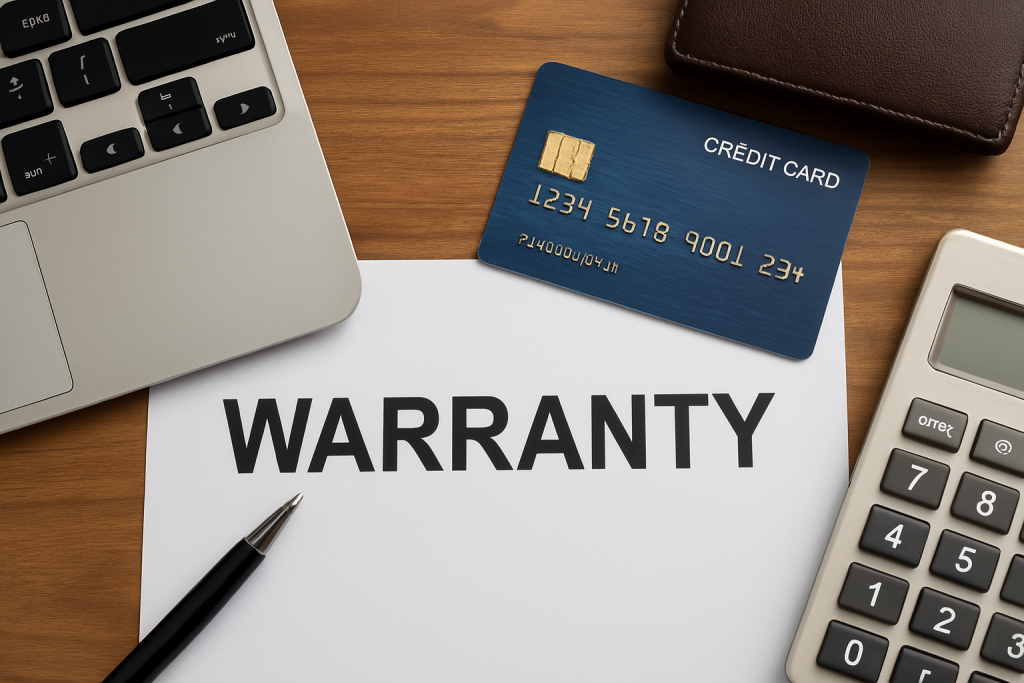Many people use credit cards for everyday purchases, but few realize they may be leaving valuable protections on the table. One of the most underrated benefits is the extended warranty coverage some credit cards offer on eligible items. When used correctly, this perk can save hundreds of dollars in repair or replacement costs.
Learning how to navigate these warranty features not only maximizes what you get from your card—it also adds an extra layer of peace of mind to big purchases. From electronics to appliances, extended protection through credit cards is a hidden advantage worth understanding.
Why extended warranty coverage is worth paying attention to?

When you buy something new, especially electronics or appliances, it often comes with a limited manufacturer warranty. That warranty might only last 90 days or one year. If your item breaks after that, you’re on your own—unless you paid with a credit card that extends the coverage.
Many major credit cards automatically add up to one extra year of warranty protection on qualifying purchases. That means if something goes wrong just outside the original warranty window, your credit card may cover the cost of repair or replacement. It’s a benefit few use, but one that can make a huge financial difference.
How this benefit works in practice
Extended warranty coverage is typically automatic when you use your card to make the full purchase. You don’t have to register the item or sign up for anything separately. If the item fails after the manufacturer’s warranty ends but within the extended period, you file a claim with your credit card issuer. The issuer may reimburse you for the cost of repair or replace the item altogether. Coverage often matches the original warranty terms—so if the manufacturer covers mechanical failures, your credit card’s extended warranty will too.
Who offers this benefit and on which cards
Not all credit cards offer extended warranties, but many top-tier and mid-tier ones do. Visa Signature, World Mastercard, and many American Express cards include this feature. However, terms vary, and it’s essential to check your benefits guide. Generally, the more premium the card, the more generous the warranty protection. Still, some no-annual-fee cards offer decent coverage too. Understanding what your credit cards provide helps you plan smarter and choose the best card for larger purchases.
Items typically covered by extended warranties
Most credit card extended warranty programs typically cover consumer electronics, small appliances, watches, and several other eligible items. However, there are important exclusions—vehicles, real estate, used items, and software licenses are often not included in the coverage.
Reading the fine print is key. If you’re planning to buy a high-value item like a laptop, tablet, or coffee machine, it’s worth checking whether paying with your credit card will offer that extended peace of mind. In most cases, it will, and you won’t need to pay extra.
Knowing the limits and exclusions
Every warranty benefit has conditions. Credit card issuers typically cap the maximum reimbursement per claim—often around $500 to $1,000. They also limit the total amount you can claim per year, depending on the card. Exclusions can include accidental damage, theft, or issues not covered by the original warranty. If the manufacturer doesn’t cover water damage, your credit card likely won’t either. It’s important to review your card’s full policy before assuming you’re protected.
How to file a warranty claim with your card issuer
If something you bought fails within the extended period, the first step is contacting your credit card issuer’s benefits administrator. Many major cards have dedicated online portals or phone lines for warranty support. Be prepared to gather some documentation.
You’ll usually need the item’s receipt, a copy of the manufacturer’s warranty, and possibly a repair estimate or a written diagnosis. The claim process varies slightly by issuer, but it generally takes about 5–15 business days. Timely filing is essential, so don’t delay once the product breaks.
Staying organized for smoother claims
One way to simplify warranty claims is to keep a digital file of your major purchases. Save your receipts, warranty documents, and even a screenshot of the product page. Some credit cards automatically email receipts, which can be useful. Staying organized reduces stress and speeds up the process. The smoother your documentation, the easier it is to get reimbursed. This makes your credit cards work harder for you without adding extra effort to your life.
Avoiding common mistakes
A frequent mistake is assuming that partial payments qualify. In most cases, you must pay the full purchase price with the same credit card that offers the warranty benefit. Splitting the payment with gift cards or other methods might void the coverage. Another misstep is not reading the expiration rules. Many issuers give you a limited window—often 60 or 90 days after the product fails—to file your claim. Missing that window means forfeiting the benefit your credit cards could have provided.
Making smart purchasing decisions with extended warranties in mind
When you’re shopping for big-ticket items, it pays to consider which card you use. If you have multiple credit cards, check which one offers the best warranty protection before making the purchase. It can be the deciding factor when choosing between two products or deciding whether to skip the store’s extended warranty offer.
Retailers often push expensive warranty add-ons—but when your credit card already extends coverage for free and automatically, that money stays in your pocket. Fully understanding your card’s benefits gives you the confidence to say no to those unnecessary, overpriced extras with zero hesitation.
Using the right card for the right purchase
Let’s say your travel card offers great points but no warranty protection, while your cash-back card includes a solid extended warranty. For electronics or appliances, go with the latter. You can always move rewards between cards later. This intentional approach makes your credit cards more valuable and tailored to your lifestyle. It also ensures you’re covered when something goes wrong—not just rewarded when things go right.
Planning purchases around warranty protection
Some consumers plan major purchases around their billing cycles or benefit calendars. If your credit card account renews benefits annually, timing your purchases right after renewal can help you maximize protection. Also, consider using your card’s extended warranty feature in combination with purchase protection or price matching. These stacked benefits can turn a single transaction into a much more secure experience.





